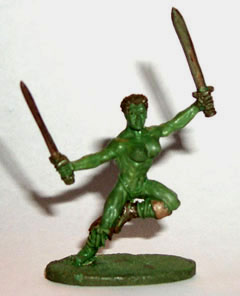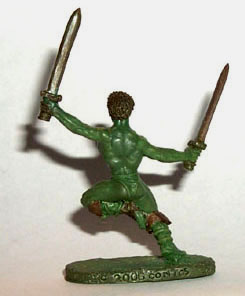JIM: In your opinion, are there any influential sculptors? KEVIN: Tom Meier
and Julie Guthrie were very influential. They sculpted true scale
highly details beautifully proportioned work. That style is out of
favor as most companies have tried to imitate the larger cartoonish style
of the European companies. Tom and Julie do toy work primarily these
days.
KEVIN: I have
learned to look at art as a job. I know some truly outstanding artists
who are doing schlock work to pay the bills. Usually a company sees
something selling from another company and tries to imitate it. Currently
everyone is doing pirates. A couple years ago everyone was doing
Samari. You really don't get to do what you want and you can do superb
work and the client will not like or it may not fit in with exactly what
they had in mind. This is nothing new. I by no means am comparing
myself to Michelangelo, but as he finished David his client the Pope was
walking around the base of the piece and decided that David’s nose was
too big. Michelangelo knew that it was perfect and the Pope was looking
from the wrong perspective. Instead of arguing he grabbed his mallet,
a chisel, and some marble dust. He climbed the scaffold and did some
gentle tapping. Not touching the statue but he let some marble dust
fall from his hands. He then asked the Pope how it looked and he
said perfect. If you are going to do any sort of artwork or any craft
that requires the client’s approval you had better develop a thick skin.
KEVIN: Yes.
I was just involved in a bit of a competition called "Visions in putty
(since we sculpt with epoxy putty)" it was centered around a general theme
of gladiator. I submitted 2 pieces. One of a very muscular
female gladiator called Virago. I was pretty happy with the results.
The second piece I did was a retiarius, one of the trident and net guys,
except he was the defeated combatant laying hewn upon the sand in his final
death throes. I have gotten quite a few compliments on it and I did
it because every body else would pose their own figures against it.
JIM: What is the hardest part of your profession? KEVIN: Other than getting paid. Planning. Most people do not know how to visualize the steps involved in t creating the final product. JIM: Do you have any words of wisdom for people wanting to get into the sculpting field? KEVIN: I will quote G. K. Chesterton "Art consists of limitation. The most beautiful part of any picture is the frame." I take this to mean, focus on what you are trying to say through your work. JIM: What artists do you look up to? KEVIN: Virgil
Finlay. A superb fantasy illustrator from the golden age of pulp
fantasy and science fiction. He did beautiful work using a very intricate
stipple technique that few have mastered. Burne Hogarth is the illustrator’s
illustrator and his fabulous books will be the standard for many years
to come. Norman Rockwell was a superb illustrator whose work is often
overlooked or dismissed as too commercial or schmaltzy. Any true
look at his masterly technique will reveal subtle brilliance. One
of my favorite sculptors is Michael Garman who currently lives in Colorado
Springs. You could easily spend a day in his studio admiring his
intricate cityscapes populated with his soulful and very human charactures.
He started from with virtually nothing bus parlayed his skill as a sculptor
and salesmanship into a very successful and well-known studio.
|








